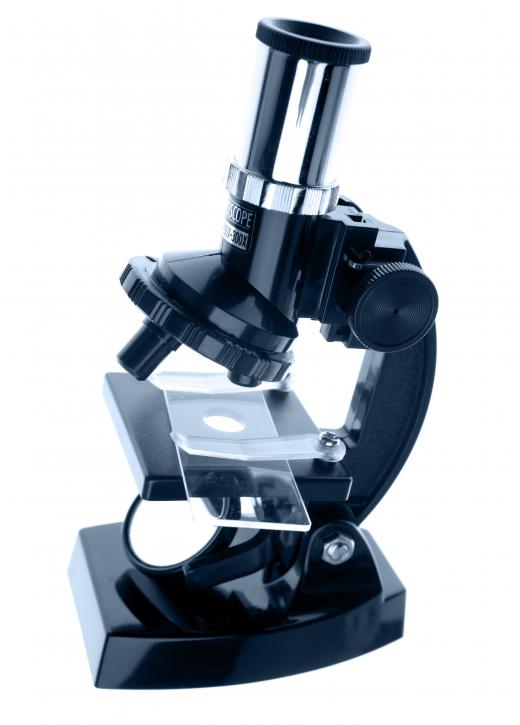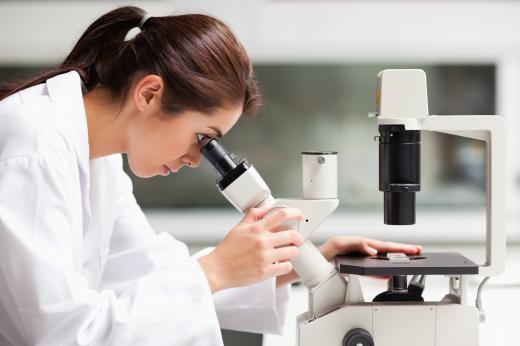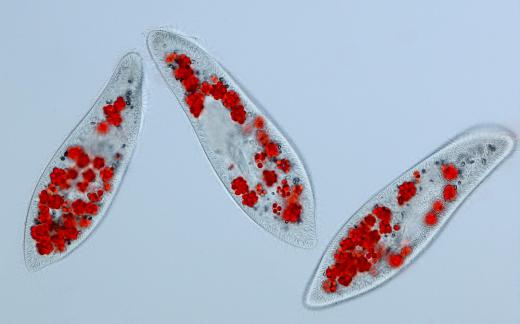What is Microscopy?
 Mary McMahon
Mary McMahon
Microscopy is a scientific discipline which involves magnifying objects which cannot be seen with the naked eye. The goal of this branch of the sciences is to render these objects visible for study, allowing researchers to learn more about them and how they work. There are a number of different types of microscopy, and innumerable applications for it. Biology in particular relies heavily on microscopy to gather information, and this scientific tool is in daily use all over the world everywhere from high school science labs to the Centers for Disease Control.
The roots of microscopy lie in the 1600s, when scientists and engineers first started to develop lenses which were capable of significant magnification, allowing people to see things which had been invisible before. An explosion in interest occurred when researchers started documenting the “animalcules,” otherwise known as microorganisms, in everything from drinking water to saliva. The realization that a miniature world existed without the knowledge of humans led researchers to refine their lenses and microscopy techniques to get better magnification and higher image resolution.

Optical microscopy, which involves the use of visible light, was the first form to be introduced. It is also sometimes known as “light microscopy.” Many people who have taken a science class have used it to look at organisms under a microscope. With electron microscopy, a 20th century invention, scientists scan an object with an electron beam. This type produces excellent magnification, but the equipment is costly and the specimens must be prepared very precisely in order to get useful results.

Another technique, scanning probe microscopy, utilizes a hand held probe to gather information about an object under investigation. It can be more versatile than electron microscopy, with a number of types of probe available for different applications.
In all cases, looking at the specimen is only the beginning. A researcher can prepare the specimen by staining it or subjecting it to chemical reactions to learn more about it, as biologists do when they submit unknown bacteria to a Gram Stain. Microscopes can also be used to assist researchers with dissections and other tasks in which they want to probe the inner workings of an organism.

Optical microscopes can be very affordable, and they can make excellent learning tools for people who are interested in the sciences. Budding scientists often greatly appreciate the gift of a microscope to explore the world around them, and they may also like working with accessories such as microscope cameras.
AS FEATURED ON:
AS FEATURED ON:















Discussion Comments
My college biology class is currently discussing fluorescence microscopy. Back in the 19th century, scientists discovered that many substances fluoresce when exposed to ultraviolet radiation. Objects like minerals, resins, crystals, chlorophyll, crude drugs, vitamins, and even butter fluoresce. What is really cool about Fluorescence Microscopy is that it can reveal even a single molecule of one of these substances when hidden as part of another substance.
This science is often used to find gene patterns in embryos as well. Fluorescence Microscopy can detect a cell’s individual components.
I have an optical microscope, and I love how I can switch so easily back and forth between levels of magnification. Some optical microscopes come with four levels of magnification, like 40x, 100x, 400x, and 1000x in one microscope. Others come in 2x, 5x, and 10x.
The objective lenses are the three tubes that you can turn over the object you are viewing. The objective turret is what you rotate to switch between different objectives. The stage is what the sample rests upon. It has two little metal pieces that you scoot the film under to hold it in place.
Optical microscopes are particularly interesting to children around the age of 9 or 10. That is the age where I had my first experience with a microscope in science class. Skin cells and hair suddenly became fascinating when enlarged hundreds of times.
My microscope had three different levels of magnification. I think that these levels were 10x, 100x, and 1000x. I scooped up some algae from our pond and magnified it 1000x, and it looked like a baby octopus!
Post your comments